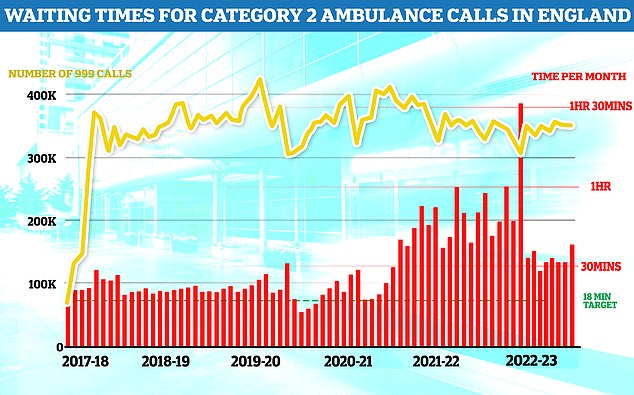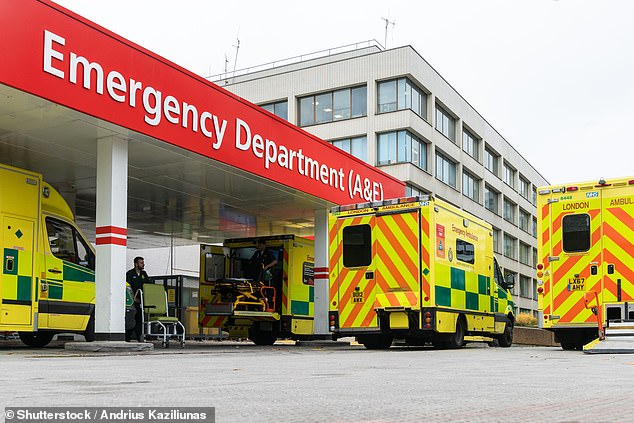One and a half million patients waited more than 12 hours after arriving at A&E in England last year, figures reveal.
For the first time, data is published showing the length of stay in an emergency department before being admitted, transferred or discharged.
These figures are separate from the regularly published “trolley wait” figures, which only measure the time elapsed after the decision to admit a patient was made.
And they show that in some NHS trusts, up to one in four patients face delays of 12 hours or more after arriving at A&E.
The Liberal Democrats, who carried out the analysis, said their findings reveal that half-day delays “have almost become the norm”.
One in four patients faces delays of 12 hours or more after arriving at the emergency department (file image)
The latest figures show that in total 1,540,945 patients faced waits of 12 hours or more after arriving at A&E between February 2023, when the new data was first published, and January 2024.
This equates to almost one in 10 patients during that period, five times more than the NHS requirement that no more than 2 per cent of patients must wait 12 hours or more from arrival at A&E.
This means around 4,200 patients waited more than 12 hours in A&E every day over the past year.
January saw the worst figures yet due to winter pressures, with a record 177,805 or one in eight patients facing emergency waits of more than 12 hours.

Ambulance data shows response times were reduced in September. Although the number of category two calls (yellow line), such as burns, epilepsy and stroke, remained static, it took 999 teams 37 minutes and 28 seconds to reach the scene (red bars). This is six minutes slower than in August and double the target of 18 minutes.
At Blackpool Teaching Hospitals, more than one in four patients in January experienced emergency delays of 12 hours or more, the worst in the country.
An 88-year-old woman was left waiting in a chair for 16 hours in the emergency room at the Royal Berkshire Hospital in Reading in January.
Another woman in her 80s waited 15 hours in the Royal Shrewsbury Hospital emergency room in December after being admitted with chest pain.
Liberal Democrat health spokesperson Daisy Cooper MP said: “Every day, thousands of patients are left frightened and suffering in overcrowded A&E, waiting 12 hours or more for the care they need.
‘Waiting of 12 hours or more can have catastrophic consequences for people’s health, especially older and vulnerable people.
“No one should have to wait this long for care, yet in some areas these unacceptably long delays have almost become the norm.” Commenting on the figures, NHS Providers chief executive Sir Julian Hartley said: “These unacceptably long waits for people in pain or distress are symptomatic of an overstretched healthcare service.
‘No trusted leader wants a patient to have to wait longer than necessary, especially as their condition could deteriorate.
‘High hospital bed occupancy rates, delays in patient discharge and severe staff shortages are slowing the flow of patients through the system.
‘Trusts are working incredibly hard to implement the national recovery plan for urgent and emergency care, but the task is beset by obstacles preventing progress at almost every turn.
‘We need sustained investment in services and a longer-term strategy to address the cycle of winter pressures that return year after year.
“A whole-of-government approach to public health issues, such as obesity and smoking, would also go a long way to preventing disease.”
A Department of Health and Social Care spokesperson said: “Cutting waiting lists is one of the government’s top five priorities and, despite winter pressures and the impact of the strike, the latest data shows waiting lists NHS overall figures have declined for the third month in a row. .
‘A&E’s performance on four-hour waits also improved in January compared to December, with the number of people seen within four hours rising to 70 per cent despite increased winter seasonal pressures and higher attendances at Registered emergencies.
“We are determined to continue improving patient care, and have already delivered on our promise to create an additional 5,000 permanent hospital beds and 10,000 home hospital beds, freeing up capacity and reducing waiting times.”


